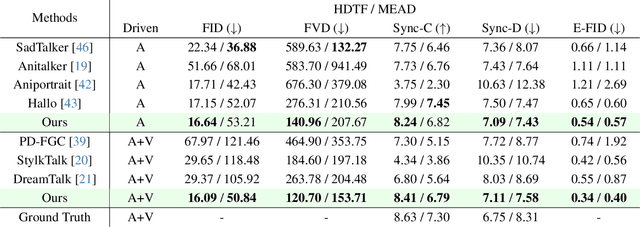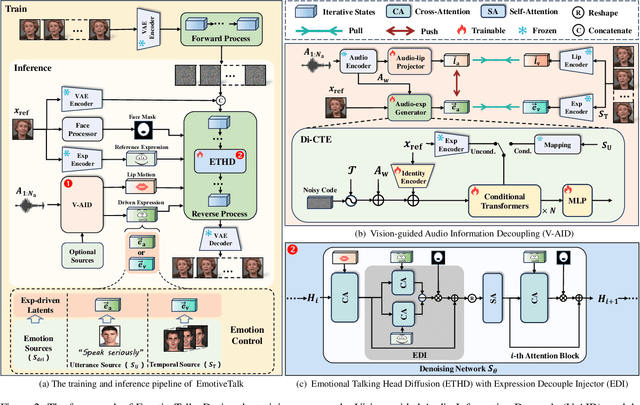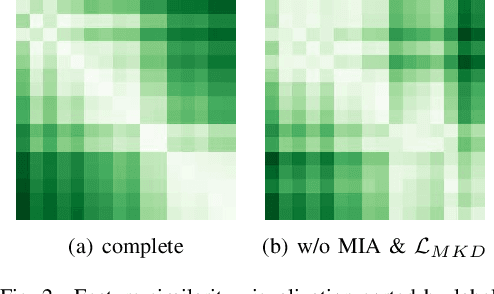Yuzhe Weng
EmotiveTalk: Expressive Talking Head Generation through Audio Information Decoupling and Emotional Video Diffusion
Nov 23, 2024



Abstract:Diffusion models have revolutionized the field of talking head generation, yet still face challenges in expressiveness, controllability, and stability in long-time generation. In this research, we propose an EmotiveTalk framework to address these issues. Firstly, to realize better control over the generation of lip movement and facial expression, a Vision-guided Audio Information Decoupling (V-AID) approach is designed to generate audio-based decoupled representations aligned with lip movements and expression. Specifically, to achieve alignment between audio and facial expression representation spaces, we present a Diffusion-based Co-speech Temporal Expansion (Di-CTE) module within V-AID to generate expression-related representations under multi-source emotion condition constraints. Then we propose a well-designed Emotional Talking Head Diffusion (ETHD) backbone to efficiently generate highly expressive talking head videos, which contains an Expression Decoupling Injection (EDI) module to automatically decouple the expressions from reference portraits while integrating the target expression information, achieving more expressive generation performance. Experimental results show that EmotiveTalk can generate expressive talking head videos, ensuring the promised controllability of emotions and stability during long-time generation, yielding state-of-the-art performance compared to existing methods.
Enhancing Multimodal Sentiment Analysis for Missing Modality through Self-Distillation and Unified Modality Cross-Attention
Oct 19, 2024



Abstract:In multimodal sentiment analysis, collecting text data is often more challenging than video or audio due to higher annotation costs and inconsistent automatic speech recognition (ASR) quality. To address this challenge, our study has developed a robust model that effectively integrates multimodal sentiment information, even in the absence of text modality. Specifically, we have developed a Double-Flow Self-Distillation Framework, including Unified Modality Cross-Attention (UMCA) and Modality Imagination Autoencoder (MIA), which excels at processing both scenarios with complete modalities and those with missing text modality. In detail, when the text modality is missing, our framework uses the LLM-based model to simulate the text representation from the audio modality, while the MIA module supplements information from the other two modalities to make the simulated text representation similar to the real text representation. To further align the simulated and real representations, and to enable the model to capture the continuous nature of sample orders in sentiment valence regression tasks, we have also introduced the Rank-N Contrast (RNC) loss function. When testing on the CMU-MOSEI, our model achieved outstanding performance on MAE and significantly outperformed other models when text modality is missing. The code is available at: https://github.com/WarmCongee/SDUMC
Hierarchical Audio-Visual Information Fusion with Multi-label Joint Decoding for MER 2023
Sep 11, 2023



Abstract:In this paper, we propose a novel framework for recognizing both discrete and dimensional emotions. In our framework, deep features extracted from foundation models are used as robust acoustic and visual representations of raw video. Three different structures based on attention-guided feature gathering (AFG) are designed for deep feature fusion. Then, we introduce a joint decoding structure for emotion classification and valence regression in the decoding stage. A multi-task loss based on uncertainty is also designed to optimize the whole process. Finally, by combining three different structures on the posterior probability level, we obtain the final predictions of discrete and dimensional emotions. When tested on the dataset of multimodal emotion recognition challenge (MER 2023), the proposed framework yields consistent improvements in both emotion classification and valence regression. Our final system achieves state-of-the-art performance and ranks third on the leaderboard on MER-MULTI sub-challenge.
* 5 pages, 4 figures
 Add to Chrome
Add to Chrome Add to Firefox
Add to Firefox Add to Edge
Add to Edge